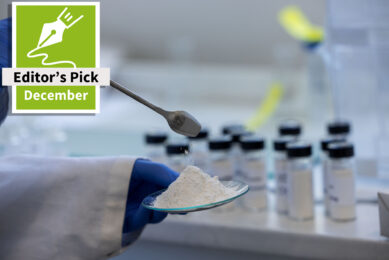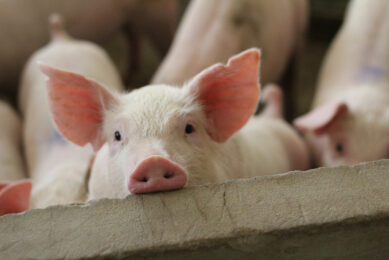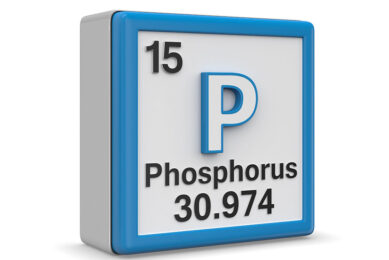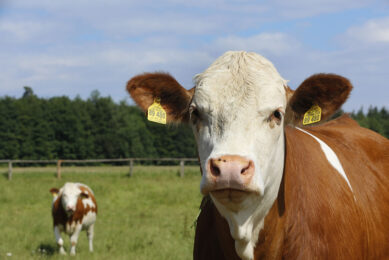Correct use of microbial phytase in pig diets
Microbial phytase is often used in diets fed to pigs because it is well established that the digestibility of phosphorus in many ingredients is increased if microbial phytase is used in the diet. The reason for this increase in digestibility is that microbial phytase has the ability to release some of the phosphorus that is bound in the phytate complex in many feed ingredients. Without phytase in the diet, most of the phytate-bound phosphorus is not digested by the pigs and is instead excreted in the manure.
Differences in the amount of phytate-bound phosphorus
There is no phytate in feed ingredients of animal origin or in inorganic sources of phosphorus such as monocalcium phosphate or dicalcium phosphate, and the digestibility of P in these ingredients is, therefore, relatively high (often greater than 80%).
In contrast, in some plant feed ingredients such as corn and soybean meal, the majority of the P is bound to phytate and the digestibility of P in these ingredients is relatively low. If phytase is added to these ingredients, the digestibility will increase.
There are, however, also a number of feed ingredients of plant origin that have less P bound in phytate than corn and soybean meal. These ingredients include many co-products from the agro-industrial industries such as DDGS, corn gluten feed, and fermented soybean meal.
Some of the P that was bound to phytate in these ingredients may have been released during production. In particular, ingredients that have been fermented or produced from the wet milling industry usually have much less phytate bound P than the parent grain had. The digestibility of P, therefore, is relatively high in these ingredients.
Different responses to microbial phytase
The efficacy of microbial phytase in terms of releasing phosphorus from a feed ingredient is proportional to the total amount of phytate bound phosphorus in the ingredient – the more phytate bound phosphorus, the greater is the release of phosphorus facilitated by microbial phytase.
The increase in digestibility of phosphorus that is observed in response to addition of phytase is, therefore, different among feed ingredients, depending on the quantity of phosphorus that is bound in phytate. This is clearly illustrated in Table 1, where the effects of adding microbial phytase to corn and three corn co-products are detailed. It appears that the effect of microbial phytase is much greater in corn and corn germ, which have a high proportion of their phosphorus bound in phytate, than in DDGS and high protein distillers grains (HP DDG), which have much less phosphorus bound in P.
Table 1 – Concentration of phosphorus and effects of microbial phytase on the standardized total tract digestibility (STTD) of P in corn and corn co-products
Item | Corn | Corn germ | DDGS | HP DDG |
Total P, % | 0.25 | 1.41 | 0.85 | 0.39 |
Phytate bound P, % | 0.18 | 1.07 | 0.26 | 0.11 |
Non-phytate bound P, % | 0.07 | 0.33 | 0.59 | 0.28 |
Phytate bound P as % of total P | 72 | 76 | 31 | 28 |
STTD of P, % with 0 units of phytase | 40.9 | 40.7 | 76.9 | 77.1 |
STTD of P with 400 units of phytase1 | 67.5 | 59.0 | 82.9 | 88.0 |
1Actual analyzed values for microbial phytase were 420, 390, 430, and 500 units for corn, corn germ, DDGS, and HP DDG, respectively.
Specify phytase effects for each ingredient
Because of the different responses to addition of microbial phytase that are observed in different feed ingredients, it is not possible to accurately formulate diets fed to pigs by using a common value for the effect of microbial phytase across all ingredients. However, if the digestibility of P in phytate containing ingredients is specified both without and with added microbial phytase then it is possible to accurately predict the value of adding microbial phytase to a mixed diet.
The implication of this is that all ingredients should have several values for the digestibility of phosphorus corresponding to the digestibility of phosphorus without and with microbial phytase. Using the values for digestibility from Table 1, the digestibility of phosphorus in corn should be entered into formulation programs at 40.9% (without phytase) and at 67.5% (with phytase). If different levels of microbial phytase are used then the digestibility of P obtained with each level of phytase should be specified. This approach will result in the most accurate way of capturing the value of microbial phytase in diets fed to pigs.











